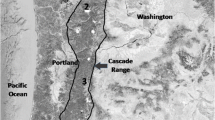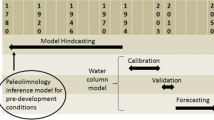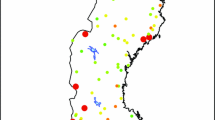Abstract
There is considerable uncertainty concerning the role of naturally occurring organic solutes in the acidification of surface waters. To provide a preliminary assessment of this process, we evaluated water chemistry data obtained from the US EPA Eastern Lake Survey (ELS). A wide range of dissolved organic carbon (DOC) and organic anion concentrations were evident across acid-sensitive lake districts in the Eastern US. In particular, lakes in Maine, the Upper Midwest and Florida contained high concentrations (greater than 1000 gmol C · L−1) of DOC. High concentrations of organic anions, estimated by discrepancy in charge balance in several subregions, suggest that dissociation of naturally occurring organic acids could significantly reduce the ANC of dilute surface waters. Unfortunately, analysis of acidification by organic solutes is complicated by uncertainty in H+ dissociation characteristics. Input of organic acids with weakly acidic pK a values do not alter acid neutralizing capacity (ANC), while strongly acidic organic functional groups dissociate completely and decrease ANC. As a first step to assess the acid/base characteristics of naturally occurring organic solutes, we calibrated the Oliver et al. (1983) model, using a reduced version of the ELS data set. This model explained 94% of the observed variability in organic anion concentration in this data set. However, model parameters obtained from the ELS calibration were somewhat different than values provided by Oliver et al. (1983), based on potentiometric titrations of pre-concentrated organic acids. The discrepancy in model parameters has implications for estimating organic anion concentrations in water using the Oliver et al. (1983) model. Finally, data from the ELS indicates that across glaciated regions of the eastern US, concentrations of DOC and organic ions were negatively correlated with SO p4inf2− . This trend would appear to be consistent with the hypothesis that inputs of strong acids immobilize organic acids, resulting in a shift of surface water acidification by organic acids to strong acids.
Similar content being viewed by others
References
Barnes, R. B.: 1976, Chem. Geol. 15, 177.
Binkley, D. and Richter, D.: 1987, Advances in Ecological Research 16, 1.
Bohn, H., McNeal, B., and O'Conner, G.: 1985, Soil Chemistry, John Wiley and Sons, New York, 340 p.
Brakke, D. F., Landers, D. H., and Eilers, J. M., 1988, Environ. Sci. Technol. 22, 155.
Davis, R. B., Anderson, D. S., and Berge, F.: 1985, Nature 316, 436.
Driscoll, C. T.: 1984, Internal. J. Environ. Anal. Chem. 16, 267.
Driscoll, C. T. and Bisogni, J. J.: 1984, ‘Weak Acid/Base Systems in Dilute Acidification Lakes and Streams in the Adirondack Region of New York State’, in J. L. Schnoor (ed.), Modeling of Total Acid Precipitation Impacts, Butterworth, Boston, p. 53.
Driscoll, C. T. and Newton, R. M.: 1985, Environ. Sci. Technol. 19, 1018.
Driscoll, C. T., Baker, J. P., Bisogni, J. J., and Schofield, C. T.: 1980, Nature 284, 161.
Driscoll, C. T., Baker, J. B., Bisogni, J. J., and Schofield, C. L.: 1984, ‘Aluminum Speciation in Dilute Acidified Surface Waters of the Adirondack Region of New York State’, in O. R. Bricker (ed.), Acid Precipitation: Geological Aspects, Butterworth, Boston, p. 55.
Driscoll, C. T., Johnson, N. M., Likens, G. E., and Feller, M. C.: 1988, Water Resour. Res. 24, 195.
Effler, S. W., Schafran, G. C., and Driscoll, C. T.: 1985, Can. J. Fish Aquat. Sci. 42, 1707.
Gherini, S. A., Mok, L., Hudson, R. J. M., Davis, G. F., Chen, C. W., and Goldstein, R. A.: 1985, Water, Air, and Soil Pollut. 26, 425.
Glover, G. M. and Webb, A. H.: 1979, Water Resour, Res. 13, 616.
Johnson, D. W. and Todd, D. E.: 1983, Soil Sci. Soc. Am. J. 47, 792.
Johnson, N. M.: 1984, ‘Acid Rain Neutralization by Geologic Materials’, in O. P. Bricker (ed.), Geologic Aspects of Acid Deposition, Butterworth, Boston, p. 37.
Krug, E. C. and Frink, C. R.: 1983, Science 221, 520.
Linthurst, R. A., Landers, P. H., Eilers, J. M., Brakke, D. F., Overton, W. S., Meier, E. P., and Crowe, R. E.: 1986, Characteristics of Lakes in the Eastern United States, Vol. 1: Population Descriptions and Physio-Chemical Relationships, EPA-600/4–86–007A, U.S. Environmental Protection Agency, Washington, D.C., 275 pp.
McDowell, W. H. and Wood, T.: 1984, Soil Sci 137, 23.
Oliver, B. G., Thurman, E. M., and Malcolm, R. L.: 1983, Geochim. Cosmochim. Acta 47, 2031.
Omernik, S. M. and Powers, C. F.: 1982, Total Alkalinity of Surface Waters — A National Map, Corvallis Environmental Research Laboratory, U.S. EPA, Corvallis, Oregon, EPA-600/D-82–333.
Perdue, E. M., Reuter, J. H., and Parrish, R. S.: 1984, Geochim. Cosmochim. Acta 48, 1257.
SAS: 1982, SAS User's Guide: Basics: 1982, SAS Institute, Cary, North Carolina, 921 pp.
Schecher, W. D. and Driscoll, C. T.: 1987, Water Resour. Res. 23, 525.
Schecher, W. D. and Driscoll, C. T.: 1988, Water Resour. Res. 24, 533.
Soil Conservation Service, USDA: 1975, Soil Taxonomy, Agricultural Handbook No. 436, US Government Printing Office, Washington, D.C., 754 pp.
Stensland, G. L.: 1984, ‘Wet Deposition Network Data with Application to Selected Problems’, in A. P. Altshuller (ed.), The Acidic Deposition Phenomenon and Its Effects: Critical Assessment Review Papers, Vol. 1, USEPA, Washington, D. C., pp. 8–31.
Thurman, E. M.: 1985, Organic Geochemistry of Natural Waters, Nijhoff/Junk Publishers, Dordrecht, The Netherlands, 497 pp.
van Breemen, N., Mulder, J., and Driscoll, C. T.: 1983, Plant Soil 75, 283.
Author information
Authors and Affiliations
Rights and permissions
About this article
Cite this article
Driscoll, C.T., Fuller, R.D. & Schecher, W.D. The role of organic acids in the acidification of surface waters in the Eastern U.S.. Water Air Soil Pollut 43, 21–40 (1989). https://doi.org/10.1007/BF00175580
Received:
Revised:
Issue Date:
DOI: https://doi.org/10.1007/BF00175580




